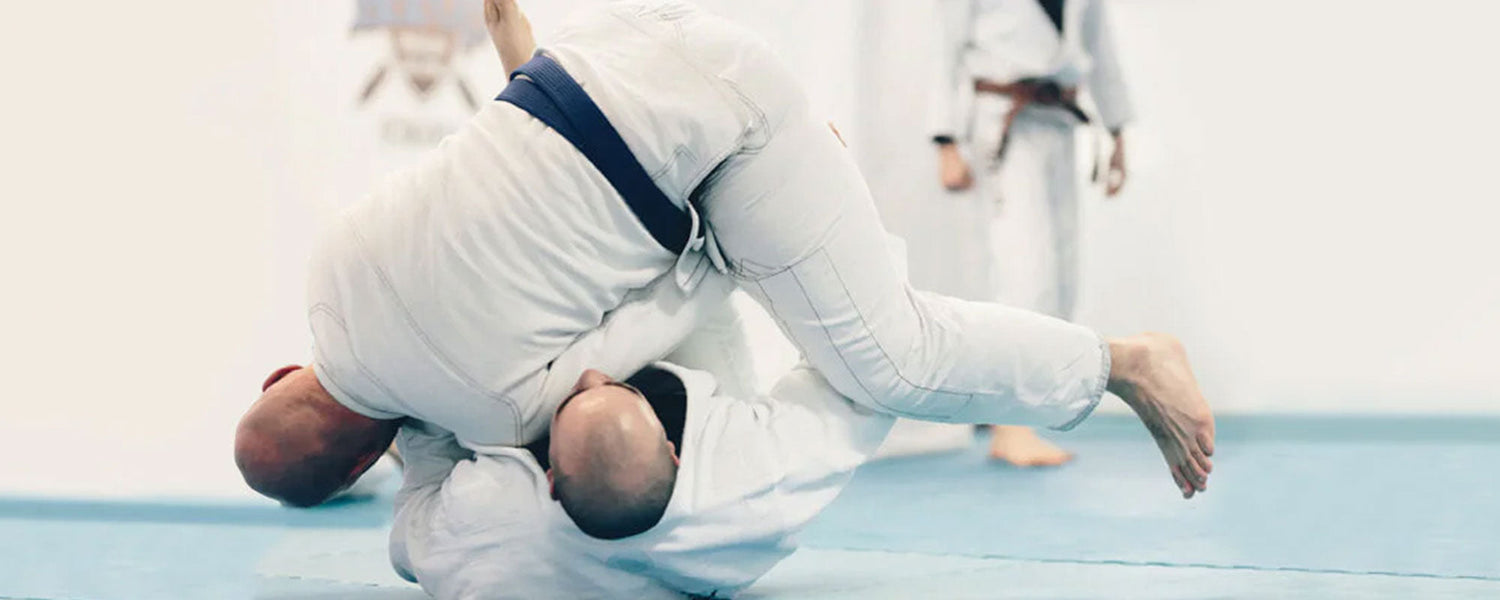Table of content
As a jiu-jitsu practitioner, you must know how a guard can help you in winning the game. Guards are one of the fundamental BJJ positions and have a lot of significance.
Every jujitsuka tries to get in guard position during a roll. If your opponent doesn’t know how to pass your guard, then he is sure to submit.
Just like Guard, Guard Passes hold a large significance in BJJ. Passing a guard can be one of your most rewarding moves during a jiu-jitsu fight.
Also read: Top 5 Guards for BJJ Beginners
Once you have mastered the art of passing a guard, then you can give your opponent a really tough time.
There may be a lot of guard passes to try out in jiu-Jitsu, they could easily get you confused because you won’t know where to start.
That’s why we bring you the top 5 guard passes in BJJ you must know for upgrading your skills.
1. Importance of Defense in BJJ
Having a better defense can surely turn the tables for you no matter the strength or submission skills of your opponent.
It’s one of the most distinctive qualities that can distinguish between a beginner and an expert.
Maintaining a strong defense doesn’t only prevent you from getting submitted but also helps you to use the opponent’s submissions against him.
In jiu-jitsu, the one way to prevent loss is to prevent getting into a submission. And, to do this you need to have a good defense.
When you have the confidence that you can escape all situations, you learn to attack the opponent more effectively.
By getting good at defense, you won’t hesitate to experiment with new techniques for submitting your opponent.
1.2. Why Guard Is a Game Changer In BJJ
Understanding how to play by getting in a guard position and how to defend it can surely upgrade your jiu-jitsu.
It is one of the most fundamental moves but is the biggest asset of every successful BJJ athlete because of several reasons.
During a BJJ fight, every jujitsuka tries to get in one of the many guard positions.
If you have mastered the guard passes then you don’t have to worry if your opponent takes the guard position because you can easily use it against them.
2. Passing Guard: Most Difficult Task in BJJ
No jiu-jitsu practitioner would ever want to get stuck in someone’s guard. Getting stuck in your opponent’s guard is rarely fun.
If your opponent is in the guard position, he has an advantage over you because you have given him better control of your body.
So, you can imagine that if your opponent is in a better position, then he can give you a tough time while passing the guard.
One of the most significant features of a BJJ guard pass is safety. Getting and staying in a guard position is easier than dealing with it.
A guard position is designed to give the bottom player all the advantages against the other.
Especially if you are a beginner in jiu-jitsu learning how to pass guard could be frustrating and quite difficult.
Let’s have a look at some simple and most effective guard passes for neutralizing the danger.
2.1. Leg Weave Guard Pass
The leg weave pass can be used most of the time when your opponent is in the half-guard or the three-quarter guard.
Getting in is a really important part of all kinds of guard passes. And, that’s what is the first aim while doing leg swing guard pass.
- You will be controlling your partner using your hands while standing between their legs. (Open guard)
- Drive your knee to the ground pushing the right thigh of your opponent into the floor.
- Now push your left elbow into the left knee of your opponent, and fix yourself between their legs.
- Throw your head onto the left shoulder of your opponent and pin him down. You can use a collar grip or under hook to put pressure.
- Lift your lower body and walk around the right side of the opponent’s body.
- Suck your right knee into the hip of the opponent and push your body with your chest.
This is one of the most favorite guard passes of most professional BJJ athletes because it’s simple to learn and your opponent cannot resist it easily.
2.2. Torenado Guard Pass
The word ‘Torenado’ is derived from the sport of bullfighting. It is because of the similarity of motion a matador makes when their leg is being charged by a bull.
The kickback he makes as the bull runs through their cape is similar to movement in a Torenado Pass.
To start this pass, you must be standing in the open guard of your opponent. There are many variations of this pass depending on the position of the opponent.
Also read: To check out some great Gi’s
For the class (side-control) torenado pass follow these steps
- While standing in the open guard of your opponent, grab their knees (Gi Fabric)
- Step back and slam their knees onto the ground.
- Walk around to the right of your opponent, make sure to keep your legs far from their body.
- Throw your head and chest onto their upper body.
- Walk back to your starting position if the opponent blocks you using their hands.
- Push your knees into the opponent’s hips, forcing their legs in the opposite direction
- Establish side control by grabbing him from the neck.
2.3. Leg Drag Pass
The leg drag pass is a popular and effective pass to control the hips of the opponent. In BJJ, the boost of power comes from your hips.
By getting control of the hips of your opponent, you can get an edge.
This pass can be highly effective in opening the closed guard of your opponent.
- Start by stepping between your opponent’s legs in the open guard.
- Grab the knee of their right leg (Fabric) with your left hand. Grab the ankle of the same leg with the right hand.
- Push the leg of your opponent forward by thrusting your hips, the leg will bend at the knee.
- Immediately get back while your hands should still be pushing the leg of your opponent.
- Now, pull the opponent’s right foot passing through your right hip.
- Pin the opponent’s left leg on the ground by pushing with your left knee.
- Move out the opponent’s right side and establish side control.
2.4. Knee Slice Pass
Knee slice pass has got your back when your opponent uses the knee shield for their defense.
This can help you in passing the open or half guard easily. The Knee slice pass is one of the passes that every BJJ beginner should learn.
- Step between your opponent’s legs.
- Grab both their knees with your hands.
- Step your left leg towards the outside of your opponent’s right leg.
- Push the inner thigh of your opponent to the floor by dropping your right on it.
- Slide your hips on the floor and get an under-hook.
- Move your body towards the right side of the opponent and establish side control.
If executed correctly, this could be a lethal guard pass which can cause the opponent to submit if the side control is strong.
2.5. The X-Guard Pass
As the name suggests, the x-guard pass is used for passing the famous x-guard.
X-guard is one of the most efficient ways to sweep your opponent. Establishing an x-guard gives you the advantage of compromising the balance of the opponent.
This guard was developed by the world-famous Marcelo Garcia himself. It is a better version of the torenado pass.
Follow these steps to pass an X-Guard
- Imagine that your opponent has applied an x-guard on your left leg.
- You will open their legs using both hands.
- As soon as you try to open it, he will switch the x-guard to your right leg.
- Immediately put your left knee on the chest of your opponent and put pressure.
- Lift the right leg and push your opponent’s left thigh downwards.
- Put pressure on the opponent’s left leg using your arm. And, push your body backward to get away from your opponent.
3. Tips To Improve your Guard Pass
You will be needing a lot of practice under the right guidance if you wish to master the art of guard passing.
The fundamental principle of perfecting your guard passing is to know which guard pass will be used according to the situation.
No doubt, BJJ is a complex sport. All the techniques in jiu-jitsu are multi-layered, you cannot stick with some types of skills if you wish to become an expert.
You can’t only rely upon regular training when training for jiu-jitsu. Studying different techniques is very important to get a grasp of BJJ methodologies.
You should also know what counters your opponent could throw for making your pass unsuccessful. These are some useful tips that can help to improve your guard pass.
3.1. Develop Strong Grips
Having a strong grip is extremely important in BJJ. If you have practiced the right steps for passing a guard up to perfection, it would be of no use if you don’t have a strong grip.
By developing your grip strength, you will not only see improvements in your passes but it will also complement your overall performance in jiu-jitsu.
Having a strong grip allows you to more effectively execute a guard pass and secure submission.
In most of the guard passes, you need to move from one side to the other. It requires holding your opponent for a long time. And, to keep your hold for a longer period a strong grip is a must.
Follow these tips to develop a stronger grip
- Pull-ups: You can use your Gi for this, toss it on the hanging bar, and do pull-ups by grabbing the Gi.
- Rope Climbing: Try rope climbing without taking help from your feet.
- Free Hanging: Hang with the hanging bar without doing pull-ups as long as you can.
3.2. Improve Your Flexibility
For passing guard, you need to make fast movements. And, you can only move your body swiftly if you have good flexibility.
Poor flexibility can impede your jiu-jitsu performance. A full range of motion will help you in executing guard passes effectively.
If your body has good flexibility, it wouldn’t only help you in guard passing but will also be beneficial for retaining a strong guard.
The most used body parts during a guard pass are the hips and knees. You can have a hard time executing the passes if you have knees or hips.
For better flexibility, you can practice regular stretching and cardio exercises.
3.3. Keep Your Centre of Balance Low
The greater the distance of your center of gravity from the floor, the more are the chances of being swept during a guard pass.
If your opponent is in the guard position, his main focus will be to elevate your center of balance so you could be swept easily.
Even if you have to lift your hips during the pass, be aware that your opponent can take this as an advantage.
3.4. Speed or Grip?
If we want to broadly categorize the guard passes, they can come under-speed, and the grip of jujitsuka.
Get to know what is your strong side. Either it is the speed or the tightness of your grip.
The speed passes don't require a strong grip. However, you should have attributes like quickness and agility.
Speed passes also depend on your ability to take reflex actions.
There are certain types of guard passes that require a strong and tight grip. They require high amounts of strength in the upper and lower body.
You need to decide which type of pass you can perform better. If you think that you have good strength then you can go for passes like the leg drag pass.
But if you are good with speed then you can try out something like the torenado guard pass.
4. Takeaway
For perfecting your guard passes, you need to know which pass could be used according to the situation and the skills of your opponent.
Guard is the fundamental position in BJJ through which the opponent can make you submit and maintain his defense at the same time.
That’s why it’s really important to master your guard passes. Remember to build submission strategies around your guard passes.
To develop your flexibility, strength, and speed for perfectly executing guard passes, read the best BJJ workouts at home.












Leave a comment
This site is protected by hCaptcha and the hCaptcha Privacy Policy and Terms of Service apply.